
NORMAL EYE
Light rays enter the eye through the cornea where they are refracted (bent) and pass through the pupil to finally form a sharp focus or image on the innermost sensitive layer of the eye, the retina, just like in the camera. The retina then sends this information to the brain via the optic nerve and the brain perceives the final image. When the image is exactly formed on the retina and there is no power in the eyes, it is called Emmetropia Refractive errors are eye disorders in which the light is not properly refracted to a point focus on the retina and instead a blurred image is perceived..
WHICH ARE THE VARIOUS TYPES OF REFRACTIVE ERRORS?
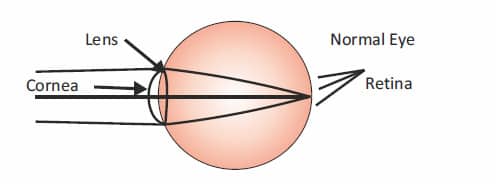
Refractive errors are eye disorders and not diseases. These include myopia, hyperopia and astigmatism. Most people have one or more of them.
HOW TO DIAGNOSE?
The common method of measuring vision loss is the vision chart. Refraction and retinoscopy can help detect the actual error and the spectacle power.

WHAT IS MYOPIA (NEARSIGHTEDNESS)?
Nearsightedness or myopia is a condition in which near objects are seen clearly, but distant objects are not clear. This occurs due to light rays focus in front of the retina due to either longer eye ball or increased corneal curvature of a steep cornea. Myopia occurs in different degrees from minimal to extreme. The more myopic you are the blurrier your vision is at a distance and objects will have to be closer to you so you can see them clearly.
Nearsightedness is a common vision condition affecting nearly 20% of the Indian population. Commonly it starts in school-age children. Because the eye continues to grow during childhood, nearsightedness may increase up to the age of 18 to 21, which generally stabilizes by then. Recent studies showed that the nearsightedness could be hereditary as well as could be caused by too much stress on the eyes in terms of very close vision work in growing children. However, larger studies are still going-on to prove these theories.

A sign of nearsightedness is difficulty in seeing distant objects like TV screen and the child may want to watch it from very near or difficulty in seeing blackboard in the school, for which the child may want to copy from the student sitting next instead of looking at the blackboard. These children may have poor class work or class notes in spite of being regular and good at home work. A comprehensive eye examination is required in such cases to rule out nearsightedness. It can be corrected by prescribing eyeglasses or contact lenses to optically correct nearsightedness, which you may only need to wear for certain activities, like watching TV or a movie or driving a car, or they may need to be worn continuously. One thing that needs to be remembered is that in case of high myopia, there is a risk of retina getting detached, which would require a surgical treatment. Hence, a regular follow-up with eye doctor is a must.
WHAT IS HYPEROPIA (FARSIGHTEDNESS)?
Farsightedness, or hyperopia is a condition in which distant objects are usually seen clearly, but close ones are not clear. Farsightedness occurs if your eyeball is shorter than the normal or the cornea is less curved than normal or flat, so light entering your eye is focused behind the retina. It is usually inherited. A child is usually born with hyperopia and as the eye grows it reduces.
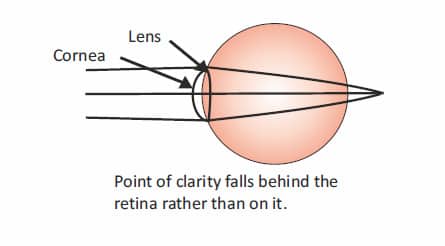
Common signs of farsightedness include difficulty in clearly seeing near objects, headaches, eye strain, and/or fatigue after close work. Although the hyperopia is not as common as myopia the common vision screenings, often done in schools, are generally ineffective in detecting this condition. A comprehensive ophthalmological examination is required in all those with above mention complaints. In mild cases of hyperopia, patient may not need corrective glasses, as eyes may be able to compensate by working harder. In other cases, your ophthalmologist may prescribe spectacle or contact lenses to optically correct this condition.
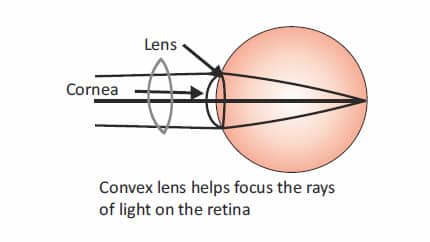
WHAT IS ASTIGMATISM (DISTORTED VISION)?
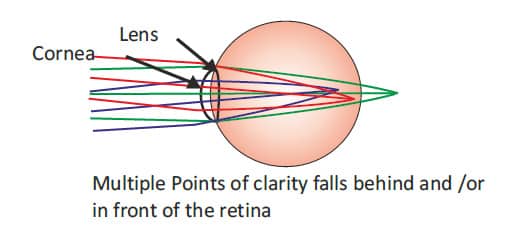
Astigmatism is a condition where the front surface of your eye, the cornea, is irregular in shape that is not perfectly round but more oval preventing the light to focus at one point on the back of your eye, the retina. As a result, the vision would be blurred at all distances. Astigmatism rarely occurs alone. It is usually accompanies myopia or hyperopia.
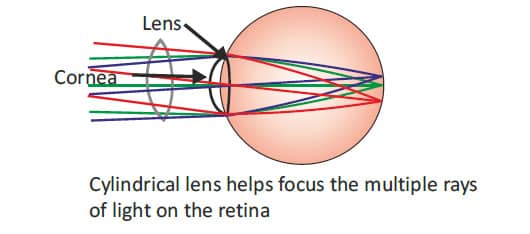
Most of astigmatism can be corrected with properly prescribed and fitted eyeglasses and/or contact lenses. However, higher astigmatism may be better handled by surgical means like astigmatic keratotomy or LASIK.
MYTHS & FACTS ‘WEARING FULL CORRECTION OF SPECTACLES CAN DAMAGE THE EYES’
Fact: For a child with a refractive error, glasses are a must, which correct the blurry vision. However, if you do not wear a full correction the vision will continue to stay blurred, so it is imperative that full correction be worn to get a clear image.
‘WEARING EYEGLASSES WILL MAKE YOU DEPENDENT ON THEM’
Fact: Eyeglasses are a must to correct the blurred vision and to see clearly. One tends to prefer wearing the glasses in order to see well against uncorrected vision. It is actually this clear vision that one gets used to.